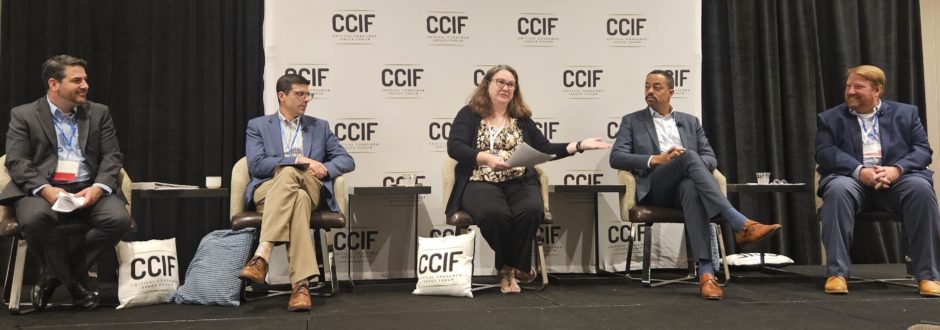In today’s electric power sector, grid modernization is well underway, and customers are exhibiting interest in a range of energy technologies, services, and applications for their homes and businesses. State commissioners, consumer advocates, and electric companies are embracing customer-focused energy solutions, while addressing challenges related to rapidly advancing technologies and evolving customer expectations. To further explore these opportunities and challenges, the Critical Consumer Issues Forum (CCIF) introduced the topic, Driving a Customer-Focused Energy Future: Examining Policies for Delivering Smart Mobility and Other Customer Solutions.
Kicking off the process with the broader topic of customer-driven solutions, CCIF quickly transitioned into more specific discussions about electric transportation. CCIF expects electric transportation issues to become increasingly relevant for the regulatory community and anticipates that the work on electric transportation will prove instructive regarding other customer-driven solutions such as energy storage and microgrids.
While there is significant interest in electric transportation by policymakers, technology providers, auto manufacturers, stakeholders, and the regulatory community, the primary driver of the topic is the increasing interest of customers in plug-in electric vehicles (PEVs or EVs). As of June 30, 2019, more than 1.27 million EVs were on the road in the United States,1 with sales projected to reach an additional 1 million per year beginning in 2023.2
The growth in electric transportation is not limited to light-duty EVs. Electric buses and other medium- and heavy-duty vehicles and equipment offer fuel and maintenance costs that are less than traditional equivalents, as well as immense emissions reduction benefits, improving air quality and public health especially for sensitive populations and communities that may be affected disproportionately.
Developed by participants during CCIF discussions, the following consensus principles on electric transportation do not address all issues with respect to this expansive topic but are meant to serve as a foundation for additional dialogue and collaboration among state commissioners, consumer advocates, electric company representatives, customers, third-party service providers, policymakers, and other stakeholders.
CCIF 2019 Consensus Principles on Electric Transportation
- Commissioners, consumer advocates, electric company representatives, and all interested stakeholders should be proactive in efforts to establish the best electric transportation policies for customers, who otherwise will continue to adopt new technologies, including electric transportation, devoid of a set policy, formalized regulatory structure, or business plan.
- Recognizing that stakeholder engagement is critical in developing balanced, beneficial programs, state commissions are encouraged to: engage stakeholders and other state energy, environmental, and transportation officials on customer-facing technologies, including electric transportation; provide as much guidance as practicable regarding specific objectives, timelines, and deliverables for collaborative stakeholder processes; and take a holistic look at the interrelated issues of grid modernization, renewable energy integration, and electric transportation.
- Managed charging can help maximize the benefits of electric transportation by improving electric system optimization and can help minimize costs for customers.
- Transportation electrification programs should be designed to improve system utilization.
- An effective way to measure usage/load data and to best communicate price signals to EV charging customers through technology is paramount to maximizing the potential benefits and minimizing the potential costs of electric transportation.
- Charging infrastructure should be deployed in a manner that provides access to electric transportation for all customers.
- When commissioners, consumer advocates, and electric company representatives are considering potential policies or evaluating proposed programs on electric transportation, they should pursue policies and programs that have the potential to maximize the benefits for the broadest range of customers while minimizing costs and managing risks for all customers.
- Electric transportation has the potential to benefit customers through emissions reductions, increased utilization of existing assets, and lower average system costs (assuming efficient charging behavior).
- Customer pricing and rates should allow for regional variation and flexibility.
- The fundamental pricing principles (i.e., Bonbright) have not changed and must be maintained with respect to new technologies, such as electric transportation.
- New rate designs will help maximize the benefit of managed charging.
- Any mechanism designed to spur market adoption should be transparent and should phase out as the market continues to grow.
- Customer education should be considered as an important component of electric company electric transportation-related programs.
- Commissioners, consumer advocates, and electric company representatives should collaborate on electric transportation-related awareness and education efforts to provide a credible, reliable source of information for customers.
CCIF’s July 2019 report on these issues may be downloaded here.
- Issues & Policy: Electric Transportation. Edison Electric Institute.http://www.eei.org/issuesandpolicy/electrictransportation/ (accessed on July 9, 2019).
- Electric Vehicle Sales Forecast and the Charging Infrastructure Required Through 2030. Edison Electric Institute and Institute for Electric Innovation. November 2018. http://www.edisonfoundation.net/iei/publications/Documents/IEI_EEI%20EV%20Forecast%20Report_Nov2018.pdf.
